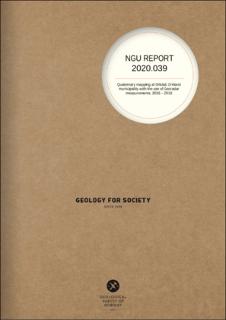| dc.description.abstract | Between November 2016 and November 2019, NGU carried out Georadar measurements in several localities in Orkland municipality in connection with mapping of Quaternary sediments. Specifically, GPR lines were measured at the wider Gjølme area (2016 - 2017), along the entire Skjenaldelva river valley (2017 - 2019) and the area around and east of Orkdal church in Fannrem (2018 - 2019). The measurements include a total of 64 individual profiles with a total length of 13.5 km. By reason of ensuring high resolution along with satisfying penetration, the main frequency used was 100 MHz. Both in-house systems available at the NGU were used according to terrain conditions i.e., PulseEKKO PRO was mostly used along roads and flat fields free of vegetation while Malå RTA was employed at more uneven\/challenging terrains.The purpose of the Georadar measurements was to provide subterrestrial information on the Orkdal sediments which would aid the project of updating the old Quaternary maps from the 1970s, resolve complex geology in selected localities and supplement a master\u2019s thesis focused on the Skjenalddalen tributary valley. This report describes all stages of the GPR survey (method, implementation, processing) and presents maps and figures for all measured radargrams. To better present the results of this 4-year survey, the total area has been divided in four distinct subareas, namely Gjølme, Skenalddalen north-east, Skjenalddalen south-west and Fannrem. For each area, a brief description of the results is given along with a general Quaternary geological interpretation.The measurements were performed over deposits of variable composition and origin, namely marine and fluvial or glaciofluvial sediments. In that sense, results vary from minimal penetration where clay is dominant to clean horizontal or dipping reflectors where fine deposits like sand or gravel prevail. In most cases, the use of 100 MHz GPR frequency yielded adequate resolution while the maximum penetration depth achieved was approximately 25 meters. The resulting radargrams revealed contacts between sediments of different composition and grain size, the hidden geometry of deposit layers, traces from old shoreline landslides in quick clay areas etc. Lastly, GPR profiles constitute a constant source of information for Skjenalddalen and Orkdal, and can be revisited to supplement future surveys in the wider area. | |

